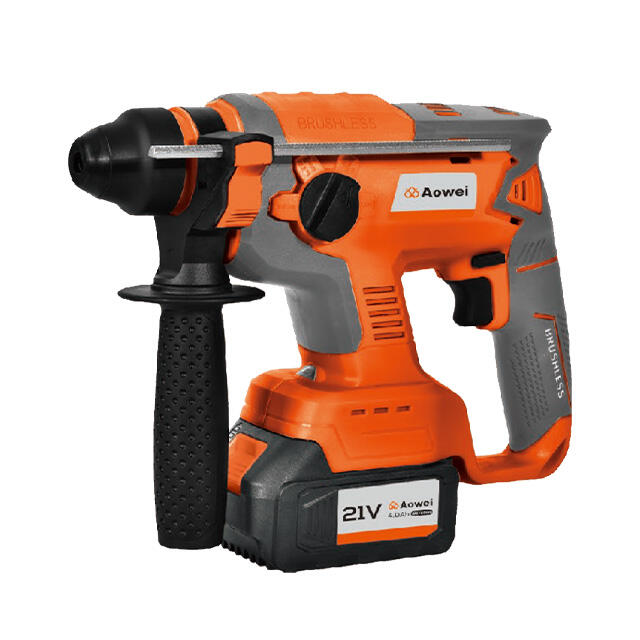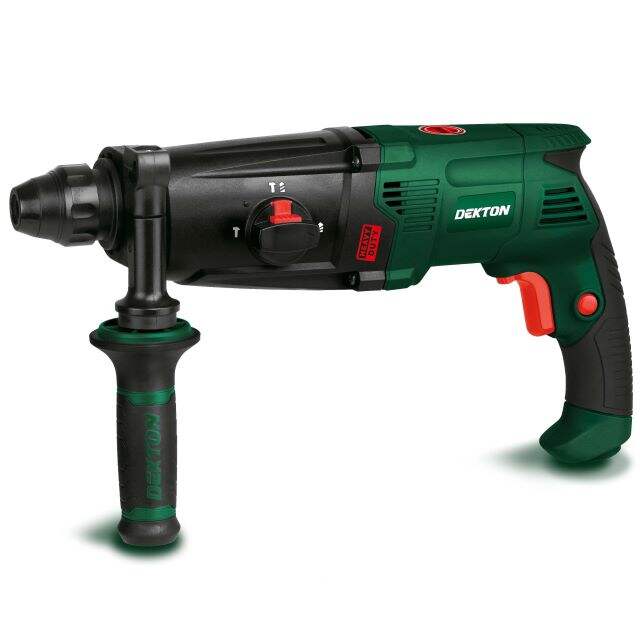إرشادات العناية الأساسية لـ مطرقة دوارة أداة
يعتمد المقاولون المحترفون وهواة الأعمال اليدوية على حد سواء على مطرقية دوارة لمهام الحفر والكَسْر الصعبة. إن صيانة المثاقب الدوارة بشكل صحيح أمر بالغ الأهمية لضمان أداء هذه الأدوات القوية بشكل متسق والحفاظ على موثوقيتها بمرور الوقت. سواء كنت تعمل في مواقع البناء أو تقوم بمشاريع تحسين المنزل، فإن فهم كيفية العناية بمثقابك الدوار يمكن أن يطيل عمره بشكل كبير ويحمي استثمارك.
إن المطرقة الدوارة التي تُحافظ عليها جيدًا لا يؤدي أداؤها بشكل أفضل فحسب، بل توفر أيضًا سلامة محسّنة أثناء التشغيل. تمنع إجراءات الصيانة المنتظمة الأعطال المفاجئة، وتقلل من تكاليف الإصلاح، وتكفل لك تحقيق أقصى استفادة من أداة العمل الخاصة بك. دعونا نستعرض استراتيجيات صيانة شاملة تحافظ على تشغيل مطرقتك الدوارة بكفاءة قصوى.
التعرف على مكونات المطرقة الدوارة
الأجزاء الحرجة ووظائفها
تبدأ فعالية صيانة المطرقة الدوارة بفهم دقيق لمكوناتها الأساسية. يحتاج نظام المشبك، الذي يثبت ويطلق رؤوس الحفر وأزاميل الكسر، إلى اهتمام خاص لأنه يتعرض لضغط شديد واهتزازات قوية. وتتألف آلية التأثير من المكبس والمضرب، وهي المسؤولة عن تحويل الحركة الدوارة إلى فعل ضرب قوي. وفي الوقت نفسه، تحتوي علبة التروس على تزييت حيوي يبقي هذه الأجزاء المتحركة تعمل بسلاسة.
تُعد المكونات الإلكترونية، بما في ذلك وحدة المحرك والمفتاح، أدوارًا حاسمة في التحكم بتشغيل الأداة. ويساعد فهم كيفية عمل هذه الأجزاء معًا في تحديد المشكلات المحتملة قبل أن تصبح مشكلات خطيرة، مما يتيح إجراء صيانة احترازية للماكينة الدوارة.
علامات البلى والمشكلات المحتملة
يمكن أن يمنع القدرة على التعرف على علامات التحذير المبكرة للبلى الإصلاحات المكلفة. وتشمل المؤشرات الشائعة الأصوات غير المعتادة أثناء التشغيل، وضعف قوة الكسر، أو الاهتزاز الزائد. وقد تدل الأبخرة أو روائح الاحتراق على وجود مشكلات كهربائية، في حين تشير تسربات الزيت إلى تدهور الختم. وتساعد الفحوصات المنتظمة لهذه المكونات في الحفاظ على الأداء الأمثل ومنع الأعطال المفاجئة.
غالبًا ما يتدهور أداء الأداة تدريجيًا، مما يجعل من السهل تجاهل المشكلات الناشئة. ويساعد إنشاء مقاييس أداء أساسية في تتبع التغيرات بمرور الوقت وتحديد الوقت الذي تكون فيه صيانة الماكينة الدوارة ضرورية.

إجراءات الصيانة اليومية
إجراءات التنظيف والتفتيش
التنظيف اليومي هو أمر أساسي للحفاظ على المطرقة الدوارة. بعد كل استخدام، قم بإزالة الغبار والشوائب باستخدام هواء مضغوط أو قطعة قماش نظيفة. واعتنِ جيدًا بفتحات التهوية، إذ يمكن أن تؤدي الفتحات المسدودة إلى ارتفاع درجة الحرارة. فحص كابل الكهرباء بحثًا عن أي قطع أو تلف، وتحقق من صحة عمل المقبض ومحاذاة القطعة.
امسح الأسطح الخارجية بقطعة قماش رطبة قليلًا لإزالة الأوساخ والأتربة. تجنب استخدام المواد الكيميائية القوية التي قد تتلف المكونات البلاستيكية أو تزيل التزييت الضروري. يمنع التنظيف المنتظم دخول الجسيمات الخشنة إلى الآلية الداخلية.
تقنيات التخزين السليمة
التخزين الصحيح هو جانب غالبًا ما يتم تجاهله في صيانة المطرقة الدوارة. احفظ الأداة في بيئة نظيفة وجافة، ويفضل أن تكون داخل علبتها الأصلية أو صندوق أدوات مخصص. وهذا يحميها من الغبار والرطوبة والأضرار المادية. افصل الشواكيخ والملحقات قبل التخزين لتجنب الضغط غير اللازم على آلية المقبض.
فكر في استخدام أكياس هلام السيليكا داخل علبة التخزين لامتصاص الرطوبة، خاصة في البيئات الرطبة. يُطيل التخزين السليم من عمر الأداة ويضمن جاهزيتها للاستخدام الفوري عند الحاجة.
مهام الصيانة الشهرية
متطلبات التزييت
يُعد التزييت المنتظم أمرًا بالغ الأهمية للحفاظ على المطرقة الدوارة. تحقق من زيت التروس وأعد تعبئته شهريًا أو وفقًا لمواصفات الشركة المصنعة. استخدم فقط مواد التشحيم الموصى بها لضمان التشغيل السليم ومنع التلف. قم بتطبيق الشحم على نظام تثبيت القاطع للحفاظ على تبديل سلس للقاطع ومنع تكون الصدأ.
نظف الشحم القديم والشوائب من نقاط التزييت قبل وضع مادة تشحيم جديدة. يمنع هذا التلوث ويضمن توزيعًا فعالًا للشحم الجديد في جميع أنحاء النظام. احتفظ بسجلات مفصلة لجداول التزييت للحفاظ على رعاية منتظمة ومتسقة.
فحوصات المكونات والتعديلات
يجب أن تشمل الفحوصات الشهرية فحصًا دقيقًا لجميع الأجزاء المتحركة. تحقق من أن مفتاح اختيار الوضع ينتقل بسلاسة بين الوظائف. اختبر آلية القابض للتأكد من التشابك والانفصال السليمين. افحص فُتات الكربون بحثًا عن علامات التآكل واستبدلها عند الحاجة للحفاظ على كفاءة المحرك.
تحقق من شد جميع البراغي والتوصيلات الخارجية، لأن الاهتزاز قد يتسبب في ترخيها مع مرور الوقت. افحص الحشيات وخواتم الأو-رين (O-rings) بحثًا عن علامات التآكل أو التلف. تساعد هذه الفحوصات المنتظمة في تحديد المشكلات المحتملة قبل أن تؤدي إلى تعطل الأداة.
سنوي خدمة المتطلبات
نقاط الفحص الاحترافية
الصيانة الاحترافية السنوية ضرورية للعناية الشاملة بالمطرقة الدوارة. يمكن للفنيين المؤهلين إجراء فحوصات مفصلة للمكونات الداخلية التي لا يمكن الوصول إليها أثناء الصيانة الروتينية. وهم يفحصون الأنظمة الكهربائية، ويقيسون تآكل المبدّل، ويقيمون حالة المحامل باستخدام معدات متخصصة.
تشمل الخدمة الاحترافية اختبار ميزات السلامة ومعايرة المكونات الإلكترونية. ويضمن هذا أن تلبي الأداة مواصفات الشركة المصنعة ومعايير السلامة. وثّق جميع الخدمات الاحترافية لأغراض الضمان وتتبع الصيانة.
استبدال العناصر التالفة
تتطلب بعض المكونات الاستبدال المنتظم بغض النظر عن وجود علامات تآكل مرئية. وتشمل هذه الختم، والحلقات المرنة، والمكونات المطاطية الأخرى التي تتدهور مع مرور الوقت. قم باستبدال فُحَص الكربون قبل أن تتآكل بالكامل لحماية محلق المحرك. نظر في استبدال فكوك المقبض أو أنظمة احتواء الرؤوس التي تُظهر علامات تآكل.
احتفظ بقطع الغيار الشائعة الاستخدام في متناول اليد لتقليل وقت التوقف. يمنع هذا النهج الاستباقي للصيانة حدوث أعطال غير متوقعة أثناء المشاريع الحيوية.
الأسئلة الشائعة
ما مدى تكرار تشحيم مطرقة الدوران الخاصة بي؟
تعتمد ترددية التزييت على شدة الاستخدام، ولكن بشكل عام، قم بتطبيق شحوم جديدة على نظام تثبيت القاطعة شهريًا وتحقق من مستويات زيت التروس كل ثلاثة أشهر. يجب على المستخدمين المكثفين زيادة ترددية التزييت وفقًا لذلك.
ما هي العلامات التي تدل على أن مثقافي الدوراني يحتاج إلى خدمة احترافية؟
ابحث عن انخفاض الأداء، أو الأصوات غير المعتادة، أو الاهتزاز المفرط، أو التلف المرئي. إذا شعرت باختلاف في أداء الأداة أثناء التشغيل أو ظهرت عليها علامات تشير إلى مشاكل كهربائية، فاطلب تقييمًا احترافيًا فورًا.
هل يمكنني إجراء جميع مهام الصيانة بنفسي؟
بينما يمكن للمستخدمين إجراء مهام الصيانة اليومية والشهرية، فإن بعض الإجراءات تتطلب خبرة احترافية وأدوات متخصصة. اتبع دائمًا إرشادات الشركة المصنعة ولا تحاول إجراء إصلاحات تتجاوز مستوى مهارتك.
ما هو العمر المتوقع لمثقاب دوار تم صيانته جيدًا؟
مع الصيانة المناسبة لأجهزة الحفر الدوارة، يمكن للأدوات من الدرجة الاحترافية أن تدوم من 5 إلى 10 سنوات أو أكثر. ومع ذلك، يختلف العمر الافتراضي بشكل كبير حسب شدة الاستخدام، وظروف العمل، وجودة الصيانة.


